Strategic Analysis Report: Nike's Business Strategies and Growth
VerifiedAdded on 2019/12/28
|17
|5722
|267
Report
AI Summary
This report delivers a comprehensive strategic analysis of Nike, a leading sports company. It begins with a corporate profile and proceeds to analyze the competitive forces using Porter's Five Forces framework, assessing threats from new entrants, suppliers, buyers, substitutes, and competitors. A PESTLE analysis examines the macro-environmental factors influencing Nike, including political, economic, social, technological, environmental, and legal aspects. The report then uses a SWOT analysis to identify Nike's strengths, weaknesses, opportunities, and threats, evaluating its core competencies and strategic purpose, including its mission, vision, and guiding principles. Finally, it suggests strategic options for growth and discusses strategy implementation, providing essential conditions for success. The report concludes with references, offering a detailed examination of Nike's strategic management.
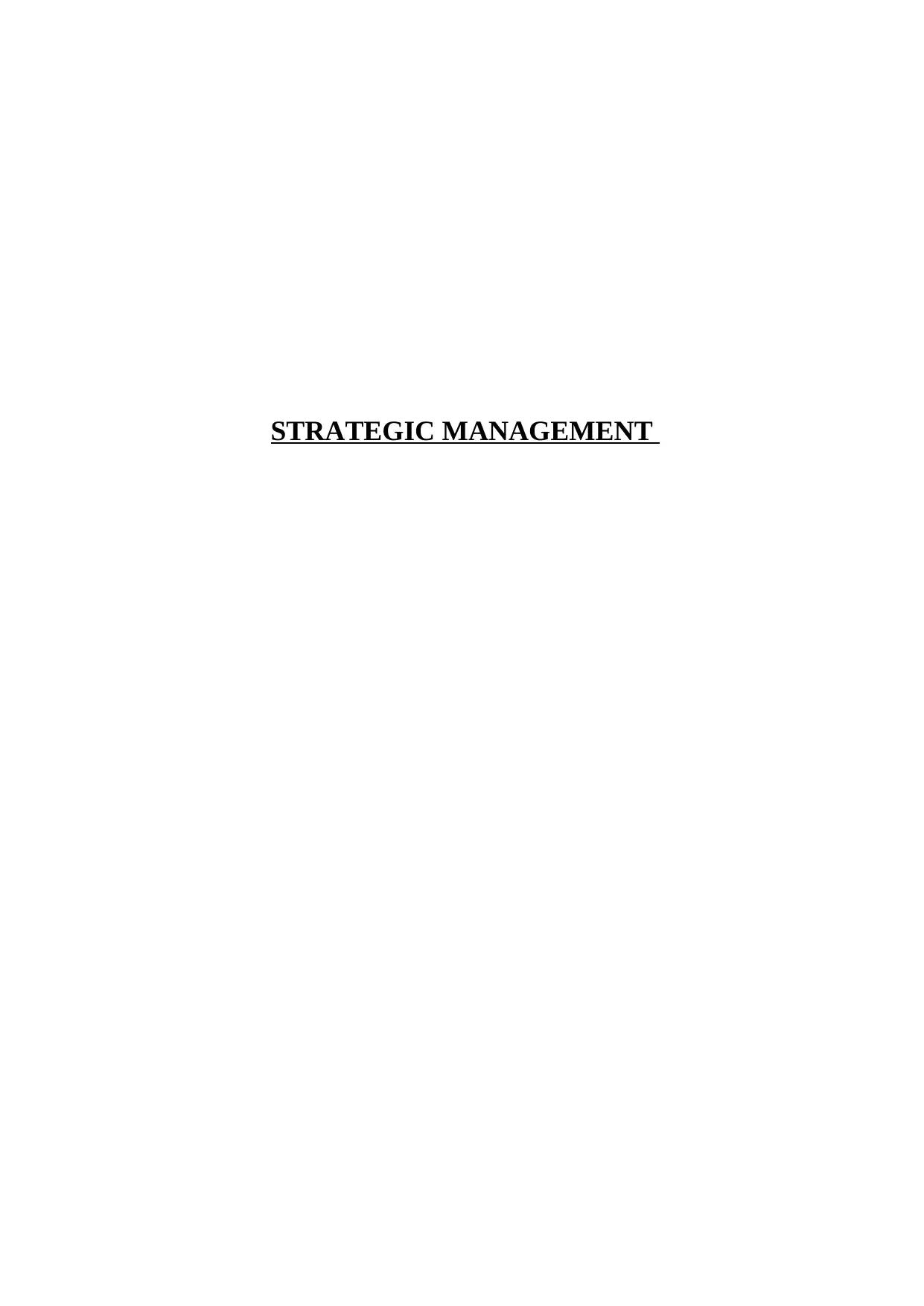
STRATEGIC MANAGEMENT
Paraphrase This Document
Need a fresh take? Get an instant paraphrase of this document with our AI Paraphraser
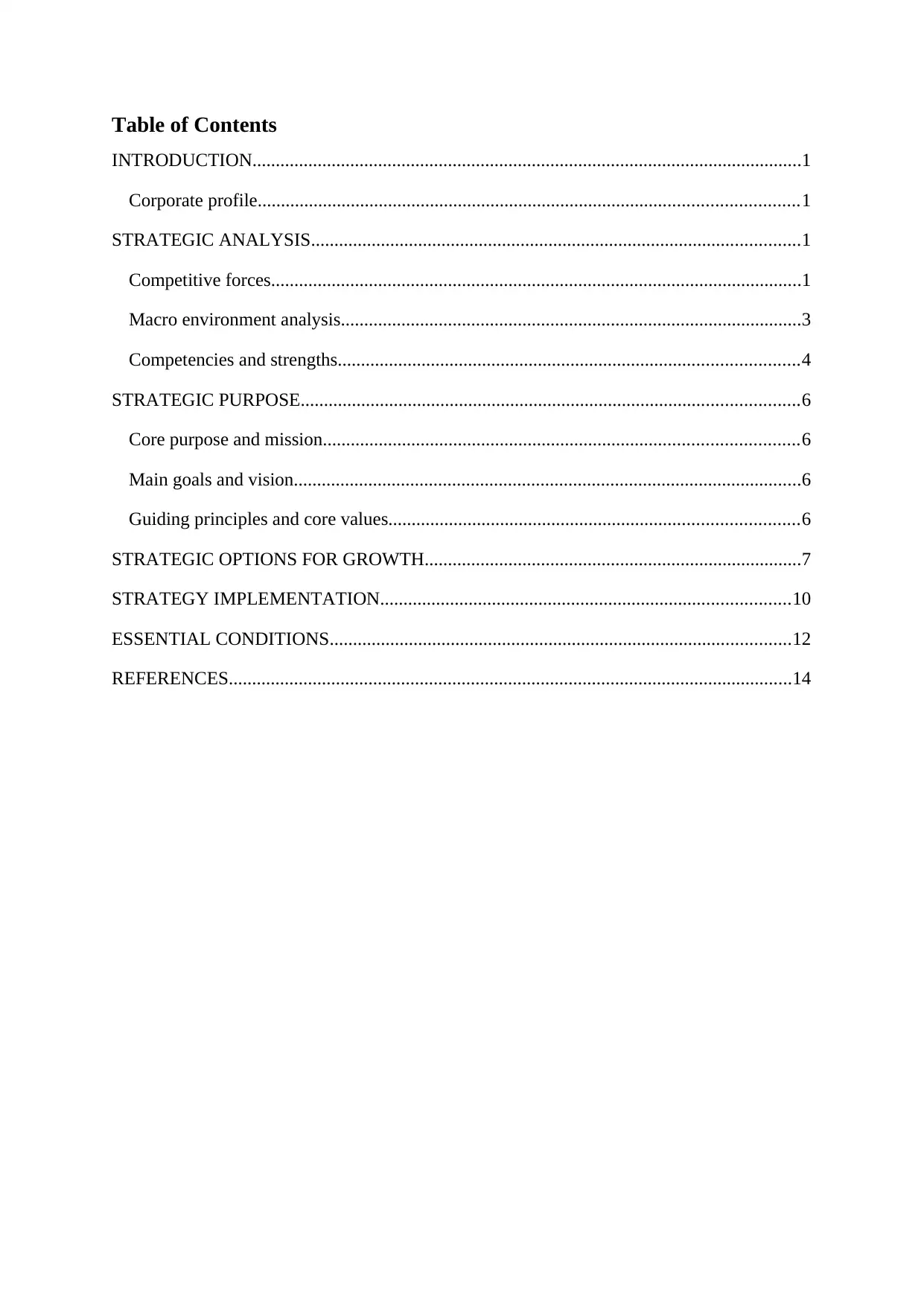
Table of Contents
INTRODUCTION......................................................................................................................1
Corporate profile....................................................................................................................1
STRATEGIC ANALYSIS.........................................................................................................1
Competitive forces..................................................................................................................1
Macro environment analysis...................................................................................................3
Competencies and strengths...................................................................................................4
STRATEGIC PURPOSE...........................................................................................................6
Core purpose and mission......................................................................................................6
Main goals and vision.............................................................................................................6
Guiding principles and core values........................................................................................6
STRATEGIC OPTIONS FOR GROWTH.................................................................................7
STRATEGY IMPLEMENTATION........................................................................................10
ESSENTIAL CONDITIONS...................................................................................................12
REFERENCES.........................................................................................................................14
INTRODUCTION......................................................................................................................1
Corporate profile....................................................................................................................1
STRATEGIC ANALYSIS.........................................................................................................1
Competitive forces..................................................................................................................1
Macro environment analysis...................................................................................................3
Competencies and strengths...................................................................................................4
STRATEGIC PURPOSE...........................................................................................................6
Core purpose and mission......................................................................................................6
Main goals and vision.............................................................................................................6
Guiding principles and core values........................................................................................6
STRATEGIC OPTIONS FOR GROWTH.................................................................................7
STRATEGY IMPLEMENTATION........................................................................................10
ESSENTIAL CONDITIONS...................................................................................................12
REFERENCES.........................................................................................................................14
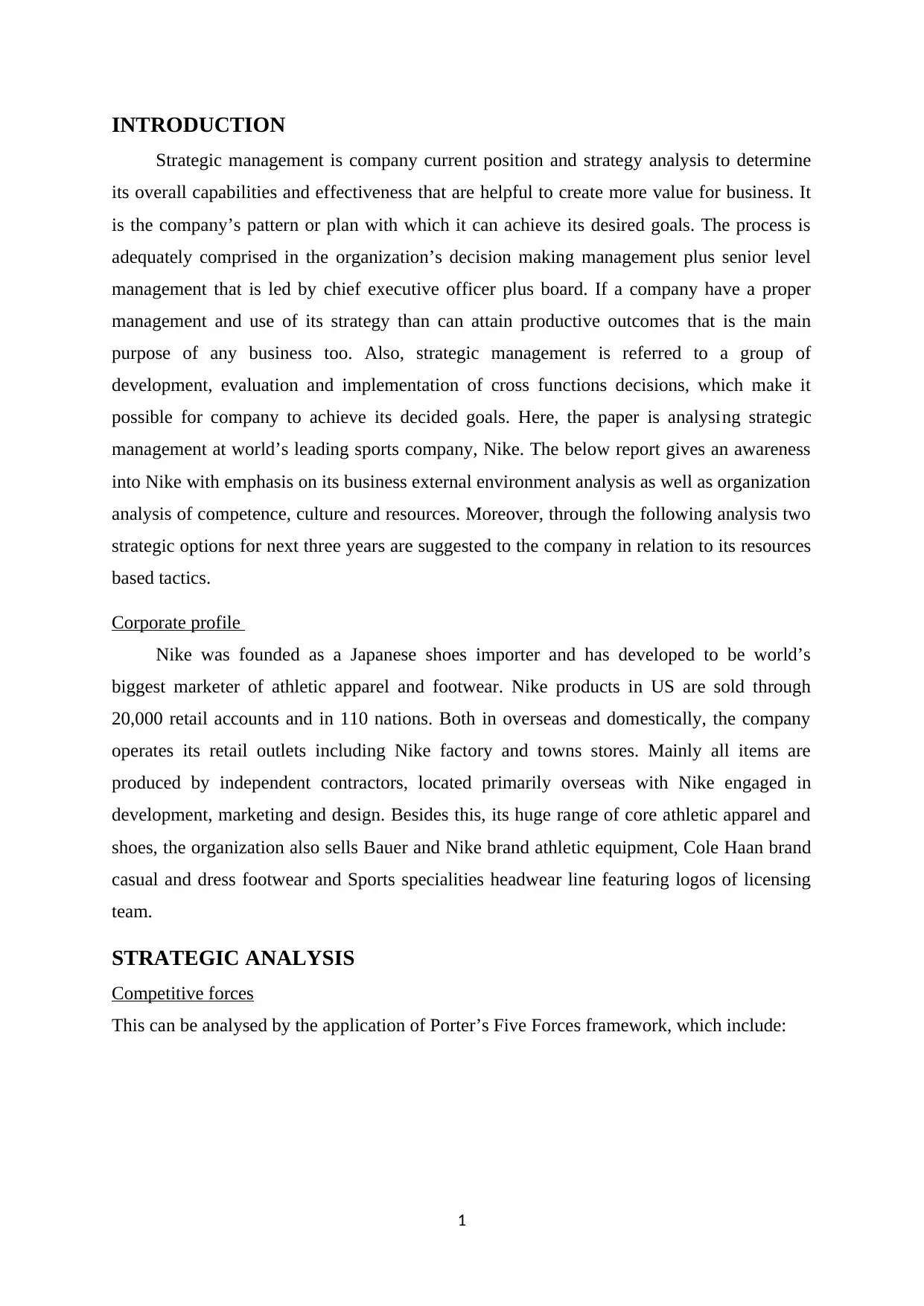
INTRODUCTION
Strategic management is company current position and strategy analysis to determine
its overall capabilities and effectiveness that are helpful to create more value for business. It
is the company’s pattern or plan with which it can achieve its desired goals. The process is
adequately comprised in the organization’s decision making management plus senior level
management that is led by chief executive officer plus board. If a company have a proper
management and use of its strategy than can attain productive outcomes that is the main
purpose of any business too. Also, strategic management is referred to a group of
development, evaluation and implementation of cross functions decisions, which make it
possible for company to achieve its decided goals. Here, the paper is analysing strategic
management at world’s leading sports company, Nike. The below report gives an awareness
into Nike with emphasis on its business external environment analysis as well as organization
analysis of competence, culture and resources. Moreover, through the following analysis two
strategic options for next three years are suggested to the company in relation to its resources
based tactics.
Corporate profile
Nike was founded as a Japanese shoes importer and has developed to be world’s
biggest marketer of athletic apparel and footwear. Nike products in US are sold through
20,000 retail accounts and in 110 nations. Both in overseas and domestically, the company
operates its retail outlets including Nike factory and towns stores. Mainly all items are
produced by independent contractors, located primarily overseas with Nike engaged in
development, marketing and design. Besides this, its huge range of core athletic apparel and
shoes, the organization also sells Bauer and Nike brand athletic equipment, Cole Haan brand
casual and dress footwear and Sports specialities headwear line featuring logos of licensing
team.
STRATEGIC ANALYSIS
Competitive forces
This can be analysed by the application of Porter’s Five Forces framework, which include:
1
Strategic management is company current position and strategy analysis to determine
its overall capabilities and effectiveness that are helpful to create more value for business. It
is the company’s pattern or plan with which it can achieve its desired goals. The process is
adequately comprised in the organization’s decision making management plus senior level
management that is led by chief executive officer plus board. If a company have a proper
management and use of its strategy than can attain productive outcomes that is the main
purpose of any business too. Also, strategic management is referred to a group of
development, evaluation and implementation of cross functions decisions, which make it
possible for company to achieve its decided goals. Here, the paper is analysing strategic
management at world’s leading sports company, Nike. The below report gives an awareness
into Nike with emphasis on its business external environment analysis as well as organization
analysis of competence, culture and resources. Moreover, through the following analysis two
strategic options for next three years are suggested to the company in relation to its resources
based tactics.
Corporate profile
Nike was founded as a Japanese shoes importer and has developed to be world’s
biggest marketer of athletic apparel and footwear. Nike products in US are sold through
20,000 retail accounts and in 110 nations. Both in overseas and domestically, the company
operates its retail outlets including Nike factory and towns stores. Mainly all items are
produced by independent contractors, located primarily overseas with Nike engaged in
development, marketing and design. Besides this, its huge range of core athletic apparel and
shoes, the organization also sells Bauer and Nike brand athletic equipment, Cole Haan brand
casual and dress footwear and Sports specialities headwear line featuring logos of licensing
team.
STRATEGIC ANALYSIS
Competitive forces
This can be analysed by the application of Porter’s Five Forces framework, which include:
1
⊘ This is a preview!⊘
Do you want full access?
Subscribe today to unlock all pages.

Trusted by 1+ million students worldwide
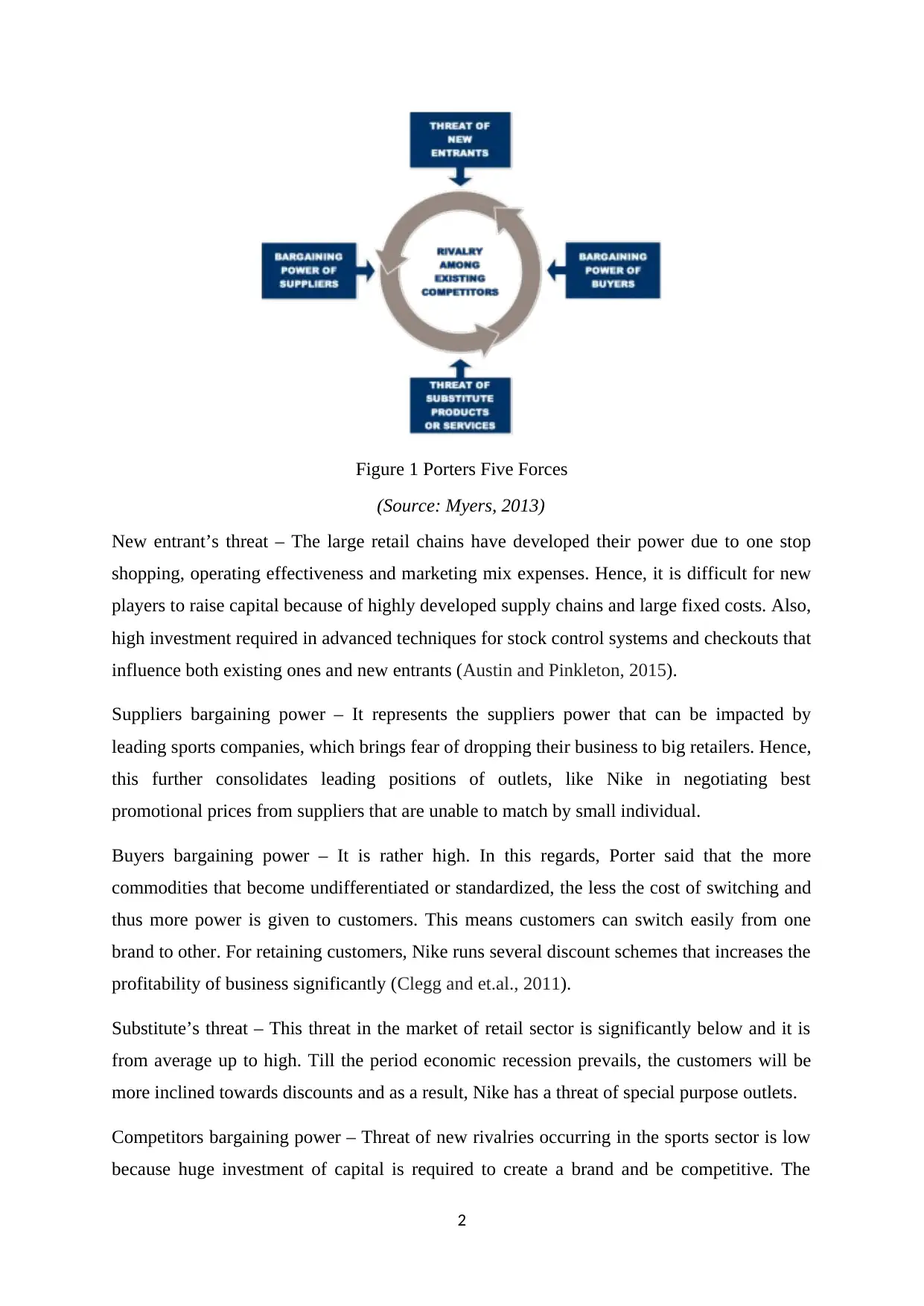
Figure 1 Porters Five Forces
(Source: Myers, 2013)
New entrant’s threat – The large retail chains have developed their power due to one stop
shopping, operating effectiveness and marketing mix expenses. Hence, it is difficult for new
players to raise capital because of highly developed supply chains and large fixed costs. Also,
high investment required in advanced techniques for stock control systems and checkouts that
influence both existing ones and new entrants (Austin and Pinkleton, 2015).
Suppliers bargaining power – It represents the suppliers power that can be impacted by
leading sports companies, which brings fear of dropping their business to big retailers. Hence,
this further consolidates leading positions of outlets, like Nike in negotiating best
promotional prices from suppliers that are unable to match by small individual.
Buyers bargaining power – It is rather high. In this regards, Porter said that the more
commodities that become undifferentiated or standardized, the less the cost of switching and
thus more power is given to customers. This means customers can switch easily from one
brand to other. For retaining customers, Nike runs several discount schemes that increases the
profitability of business significantly (Clegg and et.al., 2011).
Substitute’s threat – This threat in the market of retail sector is significantly below and it is
from average up to high. Till the period economic recession prevails, the customers will be
more inclined towards discounts and as a result, Nike has a threat of special purpose outlets.
Competitors bargaining power – Threat of new rivalries occurring in the sports sector is low
because huge investment of capital is required to create a brand and be competitive. The
2
(Source: Myers, 2013)
New entrant’s threat – The large retail chains have developed their power due to one stop
shopping, operating effectiveness and marketing mix expenses. Hence, it is difficult for new
players to raise capital because of highly developed supply chains and large fixed costs. Also,
high investment required in advanced techniques for stock control systems and checkouts that
influence both existing ones and new entrants (Austin and Pinkleton, 2015).
Suppliers bargaining power – It represents the suppliers power that can be impacted by
leading sports companies, which brings fear of dropping their business to big retailers. Hence,
this further consolidates leading positions of outlets, like Nike in negotiating best
promotional prices from suppliers that are unable to match by small individual.
Buyers bargaining power – It is rather high. In this regards, Porter said that the more
commodities that become undifferentiated or standardized, the less the cost of switching and
thus more power is given to customers. This means customers can switch easily from one
brand to other. For retaining customers, Nike runs several discount schemes that increases the
profitability of business significantly (Clegg and et.al., 2011).
Substitute’s threat – This threat in the market of retail sector is significantly below and it is
from average up to high. Till the period economic recession prevails, the customers will be
more inclined towards discounts and as a result, Nike has a threat of special purpose outlets.
Competitors bargaining power – Threat of new rivalries occurring in the sports sector is low
because huge investment of capital is required to create a brand and be competitive. The
2
Paraphrase This Document
Need a fresh take? Get an instant paraphrase of this document with our AI Paraphraser
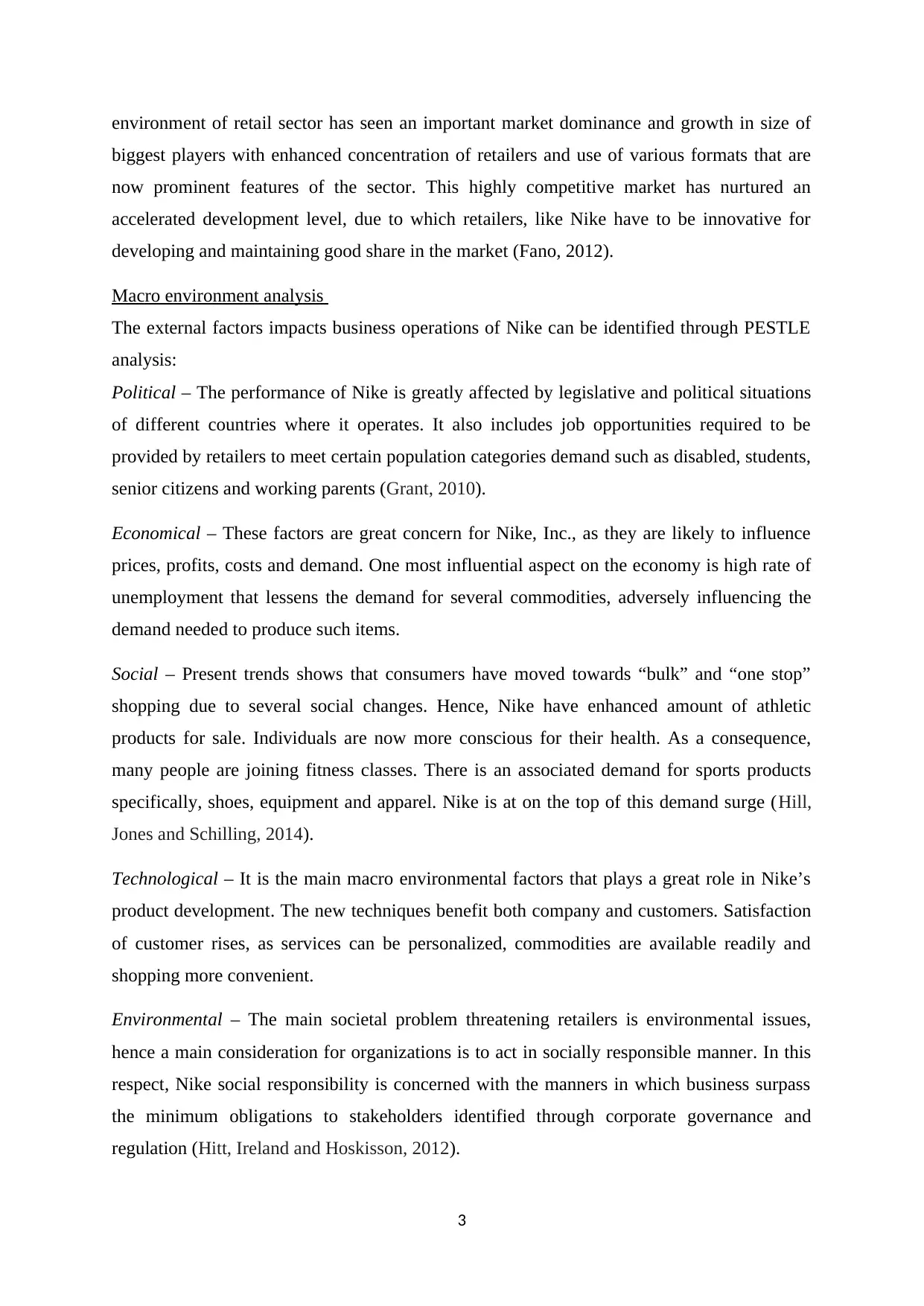
environment of retail sector has seen an important market dominance and growth in size of
biggest players with enhanced concentration of retailers and use of various formats that are
now prominent features of the sector. This highly competitive market has nurtured an
accelerated development level, due to which retailers, like Nike have to be innovative for
developing and maintaining good share in the market (Fano, 2012).
Macro environment analysis
The external factors impacts business operations of Nike can be identified through PESTLE
analysis:
Political – The performance of Nike is greatly affected by legislative and political situations
of different countries where it operates. It also includes job opportunities required to be
provided by retailers to meet certain population categories demand such as disabled, students,
senior citizens and working parents (Grant, 2010).
Economical – These factors are great concern for Nike, Inc., as they are likely to influence
prices, profits, costs and demand. One most influential aspect on the economy is high rate of
unemployment that lessens the demand for several commodities, adversely influencing the
demand needed to produce such items.
Social – Present trends shows that consumers have moved towards “bulk” and “one stop”
shopping due to several social changes. Hence, Nike have enhanced amount of athletic
products for sale. Individuals are now more conscious for their health. As a consequence,
many people are joining fitness classes. There is an associated demand for sports products
specifically, shoes, equipment and apparel. Nike is at on the top of this demand surge (Hill,
Jones and Schilling, 2014).
Technological – It is the main macro environmental factors that plays a great role in Nike’s
product development. The new techniques benefit both company and customers. Satisfaction
of customer rises, as services can be personalized, commodities are available readily and
shopping more convenient.
Environmental – The main societal problem threatening retailers is environmental issues,
hence a main consideration for organizations is to act in socially responsible manner. In this
respect, Nike social responsibility is concerned with the manners in which business surpass
the minimum obligations to stakeholders identified through corporate governance and
regulation (Hitt, Ireland and Hoskisson, 2012).
3
biggest players with enhanced concentration of retailers and use of various formats that are
now prominent features of the sector. This highly competitive market has nurtured an
accelerated development level, due to which retailers, like Nike have to be innovative for
developing and maintaining good share in the market (Fano, 2012).
Macro environment analysis
The external factors impacts business operations of Nike can be identified through PESTLE
analysis:
Political – The performance of Nike is greatly affected by legislative and political situations
of different countries where it operates. It also includes job opportunities required to be
provided by retailers to meet certain population categories demand such as disabled, students,
senior citizens and working parents (Grant, 2010).
Economical – These factors are great concern for Nike, Inc., as they are likely to influence
prices, profits, costs and demand. One most influential aspect on the economy is high rate of
unemployment that lessens the demand for several commodities, adversely influencing the
demand needed to produce such items.
Social – Present trends shows that consumers have moved towards “bulk” and “one stop”
shopping due to several social changes. Hence, Nike have enhanced amount of athletic
products for sale. Individuals are now more conscious for their health. As a consequence,
many people are joining fitness classes. There is an associated demand for sports products
specifically, shoes, equipment and apparel. Nike is at on the top of this demand surge (Hill,
Jones and Schilling, 2014).
Technological – It is the main macro environmental factors that plays a great role in Nike’s
product development. The new techniques benefit both company and customers. Satisfaction
of customer rises, as services can be personalized, commodities are available readily and
shopping more convenient.
Environmental – The main societal problem threatening retailers is environmental issues,
hence a main consideration for organizations is to act in socially responsible manner. In this
respect, Nike social responsibility is concerned with the manners in which business surpass
the minimum obligations to stakeholders identified through corporate governance and
regulation (Hitt, Ireland and Hoskisson, 2012).
3
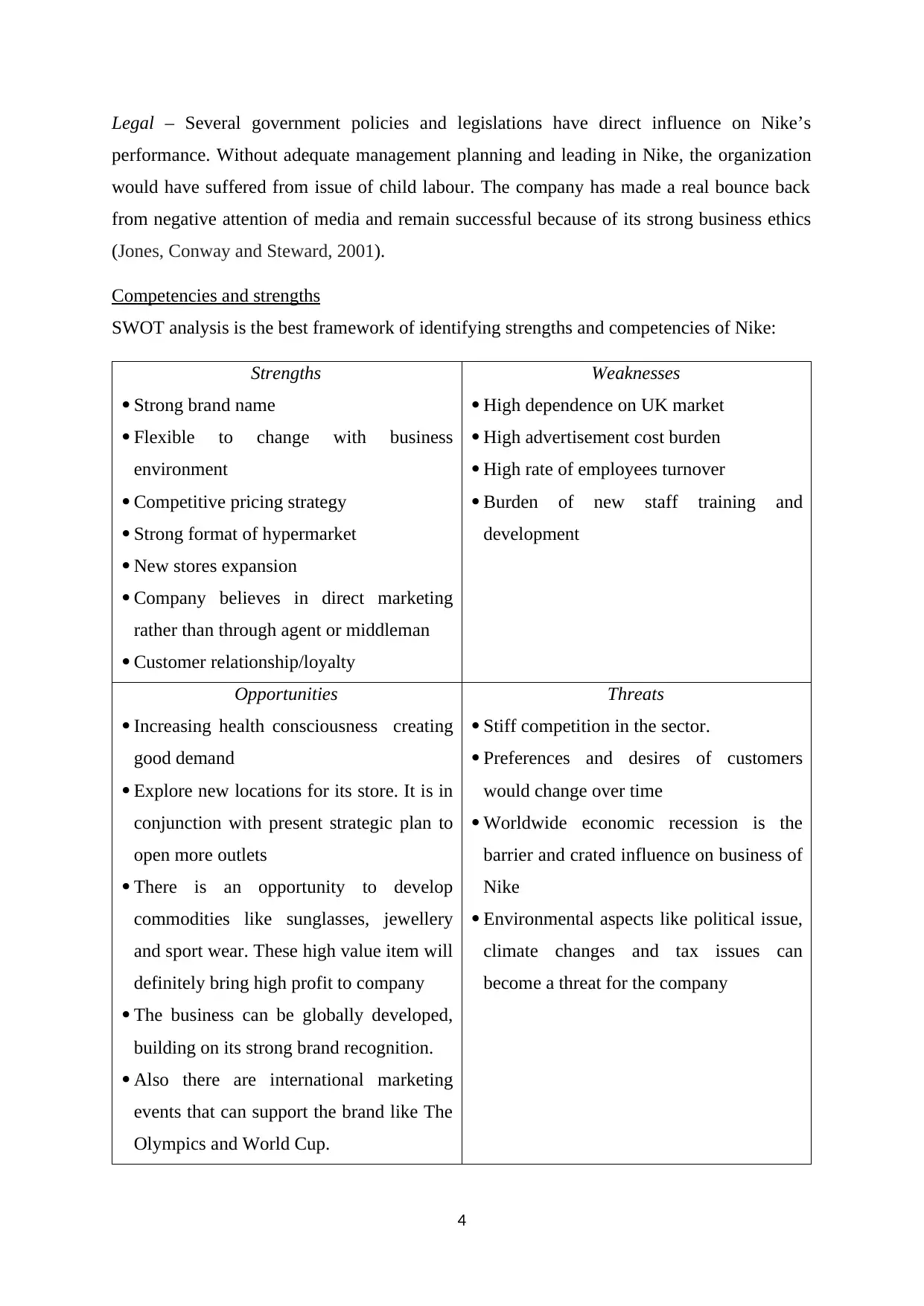
Legal – Several government policies and legislations have direct influence on Nike’s
performance. Without adequate management planning and leading in Nike, the organization
would have suffered from issue of child labour. The company has made a real bounce back
from negative attention of media and remain successful because of its strong business ethics
(Jones, Conway and Steward, 2001).
Competencies and strengths
SWOT analysis is the best framework of identifying strengths and competencies of Nike:
Strengths
Strong brand name
Flexible to change with business
environment
Competitive pricing strategy
Strong format of hypermarket
New stores expansion
Company believes in direct marketing
rather than through agent or middleman
Customer relationship/loyalty
Weaknesses
High dependence on UK market
High advertisement cost burden
High rate of employees turnover
Burden of new staff training and
development
Opportunities
Increasing health consciousness creating
good demand
Explore new locations for its store. It is in
conjunction with present strategic plan to
open more outlets
There is an opportunity to develop
commodities like sunglasses, jewellery
and sport wear. These high value item will
definitely bring high profit to company
The business can be globally developed,
building on its strong brand recognition.
Also there are international marketing
events that can support the brand like The
Olympics and World Cup.
Threats
Stiff competition in the sector.
Preferences and desires of customers
would change over time
Worldwide economic recession is the
barrier and crated influence on business of
Nike
Environmental aspects like political issue,
climate changes and tax issues can
become a threat for the company
4
performance. Without adequate management planning and leading in Nike, the organization
would have suffered from issue of child labour. The company has made a real bounce back
from negative attention of media and remain successful because of its strong business ethics
(Jones, Conway and Steward, 2001).
Competencies and strengths
SWOT analysis is the best framework of identifying strengths and competencies of Nike:
Strengths
Strong brand name
Flexible to change with business
environment
Competitive pricing strategy
Strong format of hypermarket
New stores expansion
Company believes in direct marketing
rather than through agent or middleman
Customer relationship/loyalty
Weaknesses
High dependence on UK market
High advertisement cost burden
High rate of employees turnover
Burden of new staff training and
development
Opportunities
Increasing health consciousness creating
good demand
Explore new locations for its store. It is in
conjunction with present strategic plan to
open more outlets
There is an opportunity to develop
commodities like sunglasses, jewellery
and sport wear. These high value item will
definitely bring high profit to company
The business can be globally developed,
building on its strong brand recognition.
Also there are international marketing
events that can support the brand like The
Olympics and World Cup.
Threats
Stiff competition in the sector.
Preferences and desires of customers
would change over time
Worldwide economic recession is the
barrier and crated influence on business of
Nike
Environmental aspects like political issue,
climate changes and tax issues can
become a threat for the company
4
⊘ This is a preview!⊘
Do you want full access?
Subscribe today to unlock all pages.

Trusted by 1+ million students worldwide
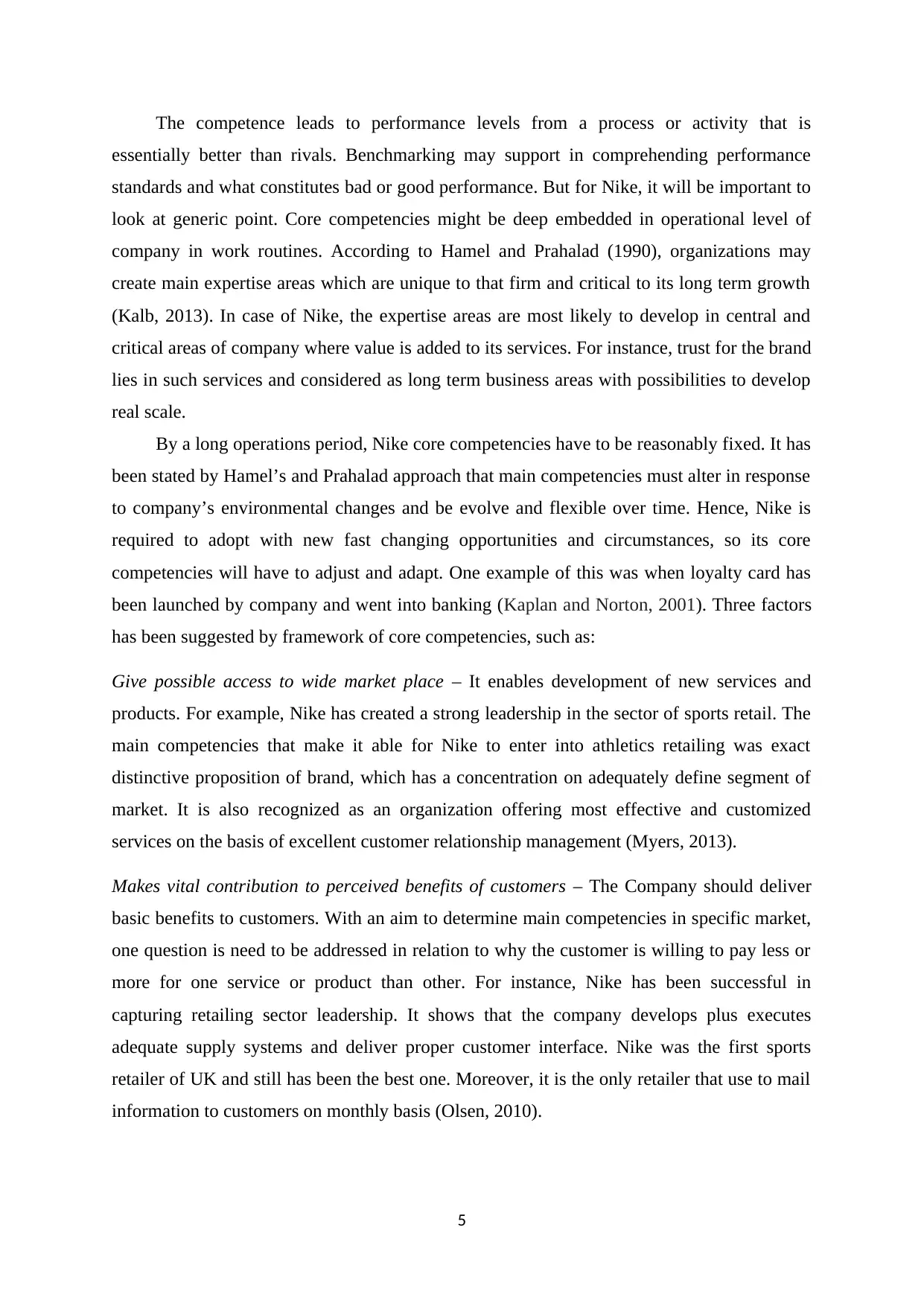
The competence leads to performance levels from a process or activity that is
essentially better than rivals. Benchmarking may support in comprehending performance
standards and what constitutes bad or good performance. But for Nike, it will be important to
look at generic point. Core competencies might be deep embedded in operational level of
company in work routines. According to Hamel and Prahalad (1990), organizations may
create main expertise areas which are unique to that firm and critical to its long term growth
(Kalb, 2013). In case of Nike, the expertise areas are most likely to develop in central and
critical areas of company where value is added to its services. For instance, trust for the brand
lies in such services and considered as long term business areas with possibilities to develop
real scale.
By a long operations period, Nike core competencies have to be reasonably fixed. It has
been stated by Hamel’s and Prahalad approach that main competencies must alter in response
to company’s environmental changes and be evolve and flexible over time. Hence, Nike is
required to adopt with new fast changing opportunities and circumstances, so its core
competencies will have to adjust and adapt. One example of this was when loyalty card has
been launched by company and went into banking (Kaplan and Norton, 2001). Three factors
has been suggested by framework of core competencies, such as:
Give possible access to wide market place – It enables development of new services and
products. For example, Nike has created a strong leadership in the sector of sports retail. The
main competencies that make it able for Nike to enter into athletics retailing was exact
distinctive proposition of brand, which has a concentration on adequately define segment of
market. It is also recognized as an organization offering most effective and customized
services on the basis of excellent customer relationship management (Myers, 2013).
Makes vital contribution to perceived benefits of customers – The Company should deliver
basic benefits to customers. With an aim to determine main competencies in specific market,
one question is need to be addressed in relation to why the customer is willing to pay less or
more for one service or product than other. For instance, Nike has been successful in
capturing retailing sector leadership. It shows that the company develops plus executes
adequate supply systems and deliver proper customer interface. Nike was the first sports
retailer of UK and still has been the best one. Moreover, it is the only retailer that use to mail
information to customers on monthly basis (Olsen, 2010).
5
essentially better than rivals. Benchmarking may support in comprehending performance
standards and what constitutes bad or good performance. But for Nike, it will be important to
look at generic point. Core competencies might be deep embedded in operational level of
company in work routines. According to Hamel and Prahalad (1990), organizations may
create main expertise areas which are unique to that firm and critical to its long term growth
(Kalb, 2013). In case of Nike, the expertise areas are most likely to develop in central and
critical areas of company where value is added to its services. For instance, trust for the brand
lies in such services and considered as long term business areas with possibilities to develop
real scale.
By a long operations period, Nike core competencies have to be reasonably fixed. It has
been stated by Hamel’s and Prahalad approach that main competencies must alter in response
to company’s environmental changes and be evolve and flexible over time. Hence, Nike is
required to adopt with new fast changing opportunities and circumstances, so its core
competencies will have to adjust and adapt. One example of this was when loyalty card has
been launched by company and went into banking (Kaplan and Norton, 2001). Three factors
has been suggested by framework of core competencies, such as:
Give possible access to wide market place – It enables development of new services and
products. For example, Nike has created a strong leadership in the sector of sports retail. The
main competencies that make it able for Nike to enter into athletics retailing was exact
distinctive proposition of brand, which has a concentration on adequately define segment of
market. It is also recognized as an organization offering most effective and customized
services on the basis of excellent customer relationship management (Myers, 2013).
Makes vital contribution to perceived benefits of customers – The Company should deliver
basic benefits to customers. With an aim to determine main competencies in specific market,
one question is need to be addressed in relation to why the customer is willing to pay less or
more for one service or product than other. For instance, Nike has been successful in
capturing retailing sector leadership. It shows that the company develops plus executes
adequate supply systems and deliver proper customer interface. Nike was the first sports
retailer of UK and still has been the best one. Moreover, it is the only retailer that use to mail
information to customers on monthly basis (Olsen, 2010).
5
Paraphrase This Document
Need a fresh take? Get an instant paraphrase of this document with our AI Paraphraser
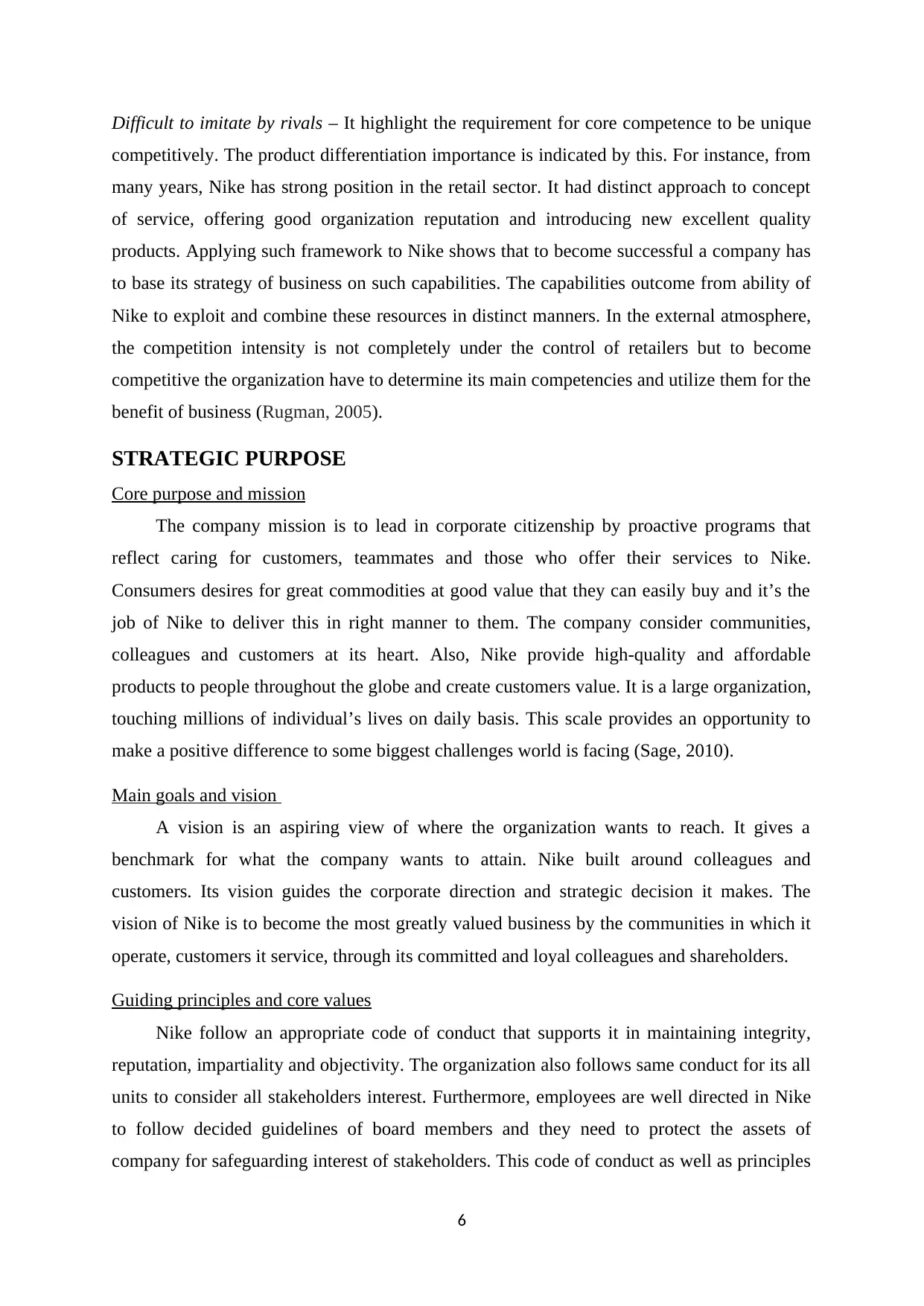
Difficult to imitate by rivals – It highlight the requirement for core competence to be unique
competitively. The product differentiation importance is indicated by this. For instance, from
many years, Nike has strong position in the retail sector. It had distinct approach to concept
of service, offering good organization reputation and introducing new excellent quality
products. Applying such framework to Nike shows that to become successful a company has
to base its strategy of business on such capabilities. The capabilities outcome from ability of
Nike to exploit and combine these resources in distinct manners. In the external atmosphere,
the competition intensity is not completely under the control of retailers but to become
competitive the organization have to determine its main competencies and utilize them for the
benefit of business (Rugman, 2005).
STRATEGIC PURPOSE
Core purpose and mission
The company mission is to lead in corporate citizenship by proactive programs that
reflect caring for customers, teammates and those who offer their services to Nike.
Consumers desires for great commodities at good value that they can easily buy and it’s the
job of Nike to deliver this in right manner to them. The company consider communities,
colleagues and customers at its heart. Also, Nike provide high-quality and affordable
products to people throughout the globe and create customers value. It is a large organization,
touching millions of individual’s lives on daily basis. This scale provides an opportunity to
make a positive difference to some biggest challenges world is facing (Sage, 2010).
Main goals and vision
A vision is an aspiring view of where the organization wants to reach. It gives a
benchmark for what the company wants to attain. Nike built around colleagues and
customers. Its vision guides the corporate direction and strategic decision it makes. The
vision of Nike is to become the most greatly valued business by the communities in which it
operate, customers it service, through its committed and loyal colleagues and shareholders.
Guiding principles and core values
Nike follow an appropriate code of conduct that supports it in maintaining integrity,
reputation, impartiality and objectivity. The organization also follows same conduct for its all
units to consider all stakeholders interest. Furthermore, employees are well directed in Nike
to follow decided guidelines of board members and they need to protect the assets of
company for safeguarding interest of stakeholders. This code of conduct as well as principles
6
competitively. The product differentiation importance is indicated by this. For instance, from
many years, Nike has strong position in the retail sector. It had distinct approach to concept
of service, offering good organization reputation and introducing new excellent quality
products. Applying such framework to Nike shows that to become successful a company has
to base its strategy of business on such capabilities. The capabilities outcome from ability of
Nike to exploit and combine these resources in distinct manners. In the external atmosphere,
the competition intensity is not completely under the control of retailers but to become
competitive the organization have to determine its main competencies and utilize them for the
benefit of business (Rugman, 2005).
STRATEGIC PURPOSE
Core purpose and mission
The company mission is to lead in corporate citizenship by proactive programs that
reflect caring for customers, teammates and those who offer their services to Nike.
Consumers desires for great commodities at good value that they can easily buy and it’s the
job of Nike to deliver this in right manner to them. The company consider communities,
colleagues and customers at its heart. Also, Nike provide high-quality and affordable
products to people throughout the globe and create customers value. It is a large organization,
touching millions of individual’s lives on daily basis. This scale provides an opportunity to
make a positive difference to some biggest challenges world is facing (Sage, 2010).
Main goals and vision
A vision is an aspiring view of where the organization wants to reach. It gives a
benchmark for what the company wants to attain. Nike built around colleagues and
customers. Its vision guides the corporate direction and strategic decision it makes. The
vision of Nike is to become the most greatly valued business by the communities in which it
operate, customers it service, through its committed and loyal colleagues and shareholders.
Guiding principles and core values
Nike follow an appropriate code of conduct that supports it in maintaining integrity,
reputation, impartiality and objectivity. The organization also follows same conduct for its all
units to consider all stakeholders interest. Furthermore, employees are well directed in Nike
to follow decided guidelines of board members and they need to protect the assets of
company for safeguarding interest of stakeholders. This code of conduct as well as principles
6
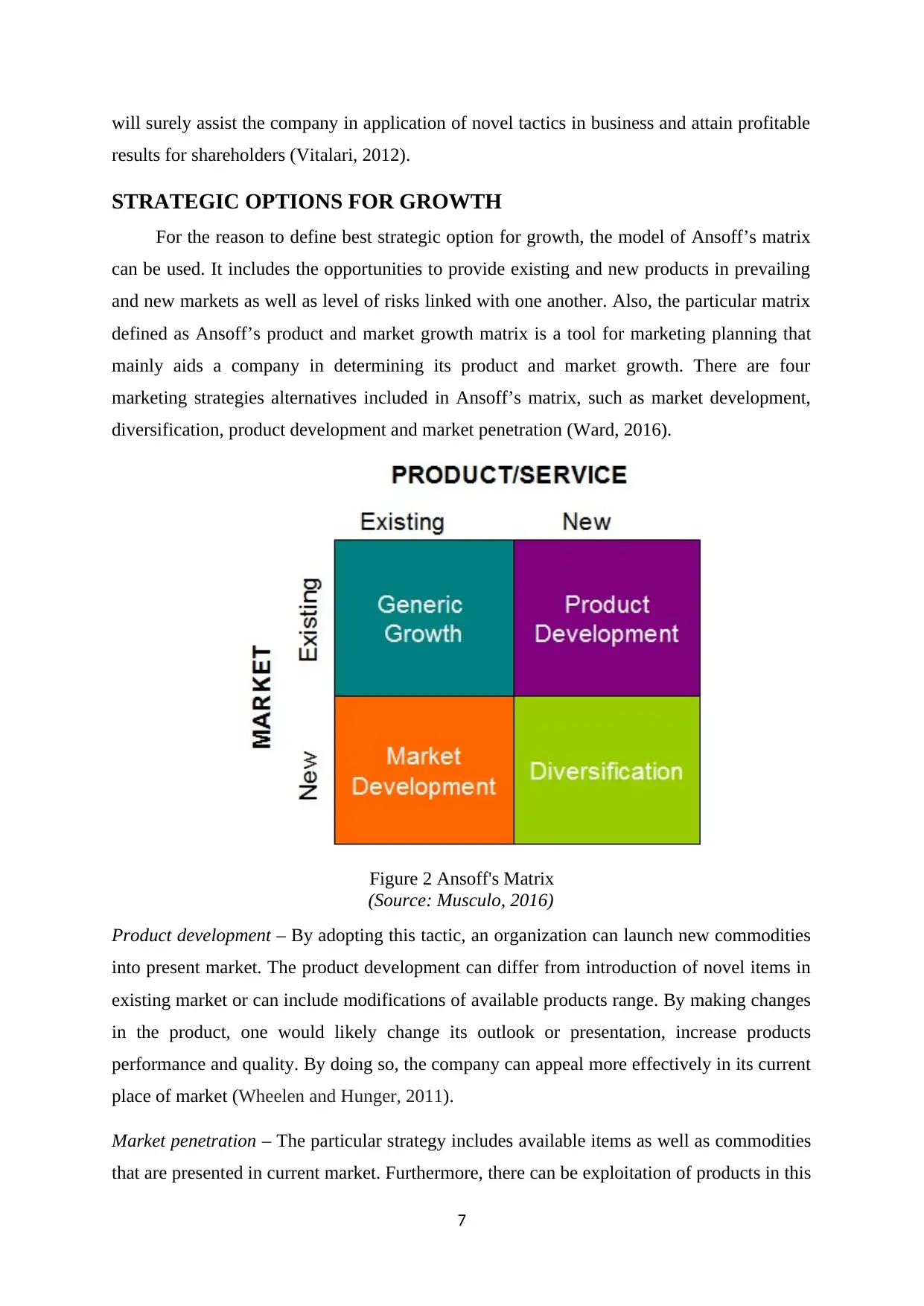
will surely assist the company in application of novel tactics in business and attain profitable
results for shareholders (Vitalari, 2012).
STRATEGIC OPTIONS FOR GROWTH
For the reason to define best strategic option for growth, the model of Ansoff’s matrix
can be used. It includes the opportunities to provide existing and new products in prevailing
and new markets as well as level of risks linked with one another. Also, the particular matrix
defined as Ansoff’s product and market growth matrix is a tool for marketing planning that
mainly aids a company in determining its product and market growth. There are four
marketing strategies alternatives included in Ansoff’s matrix, such as market development,
diversification, product development and market penetration (Ward, 2016).
Figure 2 Ansoff's Matrix
(Source: Musculo, 2016)
Product development – By adopting this tactic, an organization can launch new commodities
into present market. The product development can differ from introduction of novel items in
existing market or can include modifications of available products range. By making changes
in the product, one would likely change its outlook or presentation, increase products
performance and quality. By doing so, the company can appeal more effectively in its current
place of market (Wheelen and Hunger, 2011).
Market penetration – The particular strategy includes available items as well as commodities
that are presented in current market. Furthermore, there can be exploitation of products in this
7
results for shareholders (Vitalari, 2012).
STRATEGIC OPTIONS FOR GROWTH
For the reason to define best strategic option for growth, the model of Ansoff’s matrix
can be used. It includes the opportunities to provide existing and new products in prevailing
and new markets as well as level of risks linked with one another. Also, the particular matrix
defined as Ansoff’s product and market growth matrix is a tool for marketing planning that
mainly aids a company in determining its product and market growth. There are four
marketing strategies alternatives included in Ansoff’s matrix, such as market development,
diversification, product development and market penetration (Ward, 2016).
Figure 2 Ansoff's Matrix
(Source: Musculo, 2016)
Product development – By adopting this tactic, an organization can launch new commodities
into present market. The product development can differ from introduction of novel items in
existing market or can include modifications of available products range. By making changes
in the product, one would likely change its outlook or presentation, increase products
performance and quality. By doing so, the company can appeal more effectively in its current
place of market (Wheelen and Hunger, 2011).
Market penetration – The particular strategy includes available items as well as commodities
that are presented in current market. Furthermore, there can be exploitation of products in this
7
⊘ This is a preview!⊘
Do you want full access?
Subscribe today to unlock all pages.

Trusted by 1+ million students worldwide
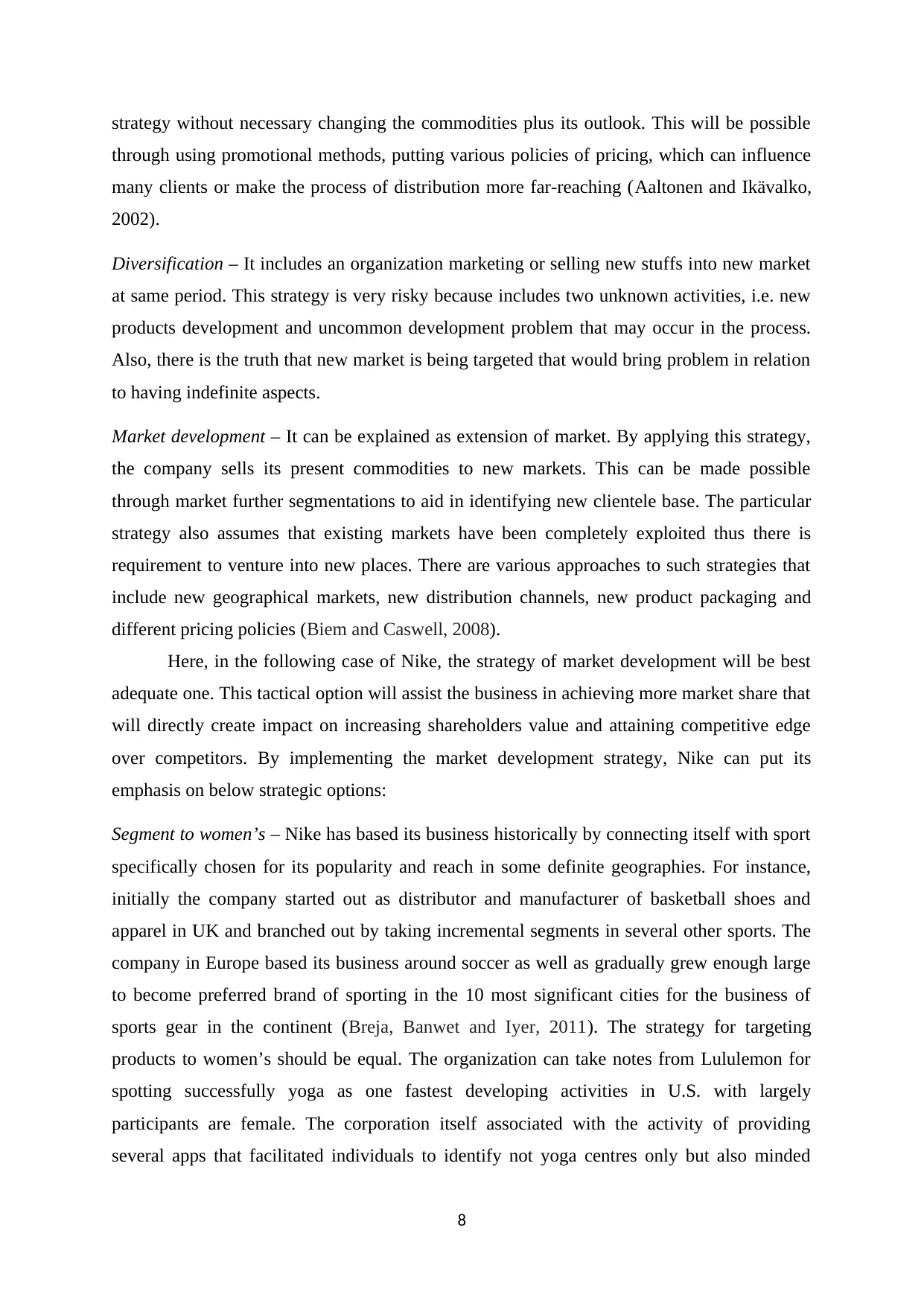
strategy without necessary changing the commodities plus its outlook. This will be possible
through using promotional methods, putting various policies of pricing, which can influence
many clients or make the process of distribution more far-reaching (Aaltonen and Ikävalko,
2002).
Diversification – It includes an organization marketing or selling new stuffs into new market
at same period. This strategy is very risky because includes two unknown activities, i.e. new
products development and uncommon development problem that may occur in the process.
Also, there is the truth that new market is being targeted that would bring problem in relation
to having indefinite aspects.
Market development – It can be explained as extension of market. By applying this strategy,
the company sells its present commodities to new markets. This can be made possible
through market further segmentations to aid in identifying new clientele base. The particular
strategy also assumes that existing markets have been completely exploited thus there is
requirement to venture into new places. There are various approaches to such strategies that
include new geographical markets, new distribution channels, new product packaging and
different pricing policies (Biem and Caswell, 2008).
Here, in the following case of Nike, the strategy of market development will be best
adequate one. This tactical option will assist the business in achieving more market share that
will directly create impact on increasing shareholders value and attaining competitive edge
over competitors. By implementing the market development strategy, Nike can put its
emphasis on below strategic options:
Segment to women’s – Nike has based its business historically by connecting itself with sport
specifically chosen for its popularity and reach in some definite geographies. For instance,
initially the company started out as distributor and manufacturer of basketball shoes and
apparel in UK and branched out by taking incremental segments in several other sports. The
company in Europe based its business around soccer as well as gradually grew enough large
to become preferred brand of sporting in the 10 most significant cities for the business of
sports gear in the continent (Breja, Banwet and Iyer, 2011). The strategy for targeting
products to women’s should be equal. The organization can take notes from Lululemon for
spotting successfully yoga as one fastest developing activities in U.S. with largely
participants are female. The corporation itself associated with the activity of providing
several apps that facilitated individuals to identify not yoga centres only but also minded
8
through using promotional methods, putting various policies of pricing, which can influence
many clients or make the process of distribution more far-reaching (Aaltonen and Ikävalko,
2002).
Diversification – It includes an organization marketing or selling new stuffs into new market
at same period. This strategy is very risky because includes two unknown activities, i.e. new
products development and uncommon development problem that may occur in the process.
Also, there is the truth that new market is being targeted that would bring problem in relation
to having indefinite aspects.
Market development – It can be explained as extension of market. By applying this strategy,
the company sells its present commodities to new markets. This can be made possible
through market further segmentations to aid in identifying new clientele base. The particular
strategy also assumes that existing markets have been completely exploited thus there is
requirement to venture into new places. There are various approaches to such strategies that
include new geographical markets, new distribution channels, new product packaging and
different pricing policies (Biem and Caswell, 2008).
Here, in the following case of Nike, the strategy of market development will be best
adequate one. This tactical option will assist the business in achieving more market share that
will directly create impact on increasing shareholders value and attaining competitive edge
over competitors. By implementing the market development strategy, Nike can put its
emphasis on below strategic options:
Segment to women’s – Nike has based its business historically by connecting itself with sport
specifically chosen for its popularity and reach in some definite geographies. For instance,
initially the company started out as distributor and manufacturer of basketball shoes and
apparel in UK and branched out by taking incremental segments in several other sports. The
company in Europe based its business around soccer as well as gradually grew enough large
to become preferred brand of sporting in the 10 most significant cities for the business of
sports gear in the continent (Breja, Banwet and Iyer, 2011). The strategy for targeting
products to women’s should be equal. The organization can take notes from Lululemon for
spotting successfully yoga as one fastest developing activities in U.S. with largely
participants are female. The corporation itself associated with the activity of providing
several apps that facilitated individuals to identify not yoga centres only but also minded
8
Paraphrase This Document
Need a fresh take? Get an instant paraphrase of this document with our AI Paraphraser
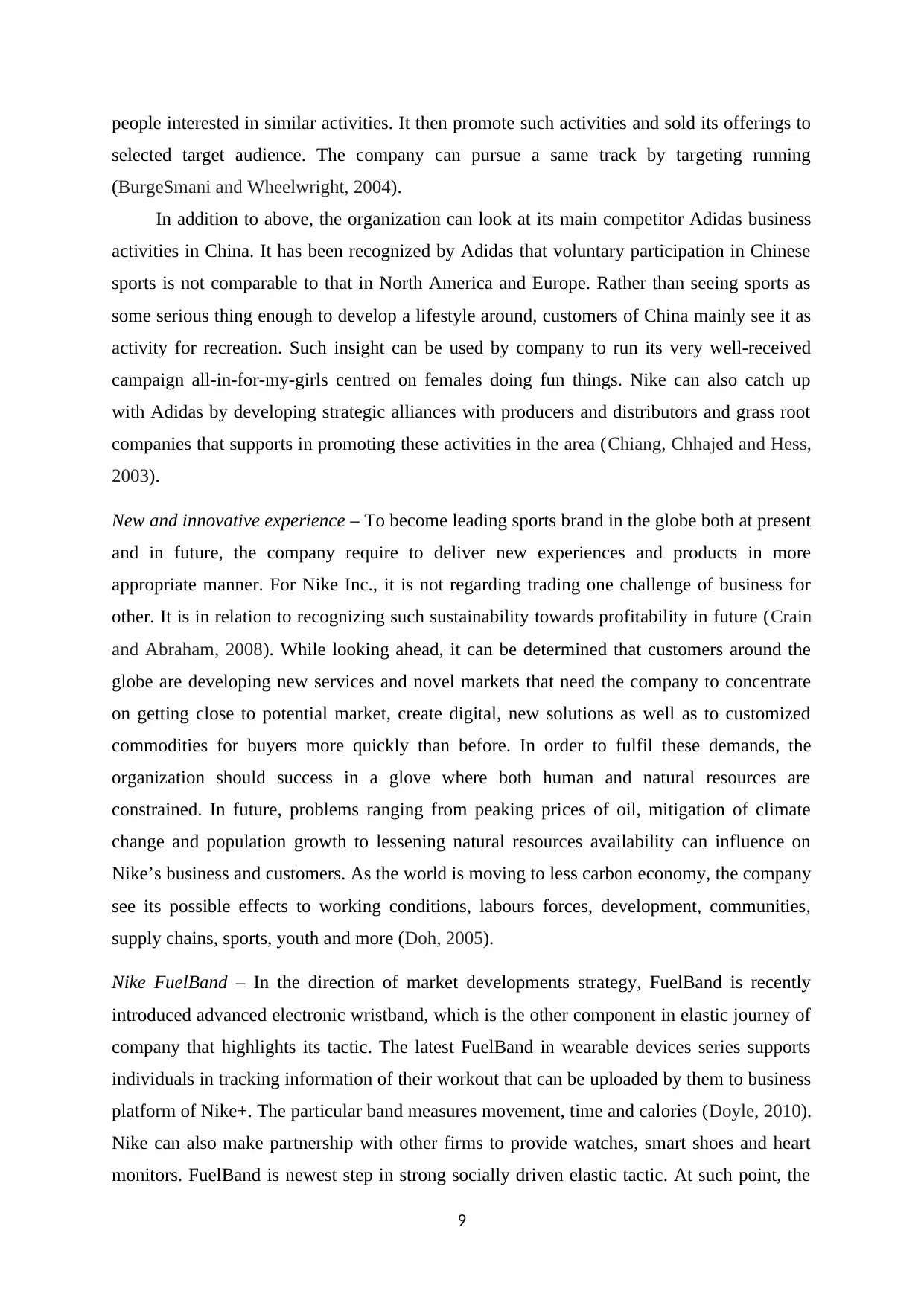
people interested in similar activities. It then promote such activities and sold its offerings to
selected target audience. The company can pursue a same track by targeting running
(BurgeSmani and Wheelwright, 2004).
In addition to above, the organization can look at its main competitor Adidas business
activities in China. It has been recognized by Adidas that voluntary participation in Chinese
sports is not comparable to that in North America and Europe. Rather than seeing sports as
some serious thing enough to develop a lifestyle around, customers of China mainly see it as
activity for recreation. Such insight can be used by company to run its very well-received
campaign all-in-for-my-girls centred on females doing fun things. Nike can also catch up
with Adidas by developing strategic alliances with producers and distributors and grass root
companies that supports in promoting these activities in the area (Chiang, Chhajed and Hess,
2003).
New and innovative experience – To become leading sports brand in the globe both at present
and in future, the company require to deliver new experiences and products in more
appropriate manner. For Nike Inc., it is not regarding trading one challenge of business for
other. It is in relation to recognizing such sustainability towards profitability in future (Crain
and Abraham, 2008). While looking ahead, it can be determined that customers around the
globe are developing new services and novel markets that need the company to concentrate
on getting close to potential market, create digital, new solutions as well as to customized
commodities for buyers more quickly than before. In order to fulfil these demands, the
organization should success in a glove where both human and natural resources are
constrained. In future, problems ranging from peaking prices of oil, mitigation of climate
change and population growth to lessening natural resources availability can influence on
Nike’s business and customers. As the world is moving to less carbon economy, the company
see its possible effects to working conditions, labours forces, development, communities,
supply chains, sports, youth and more (Doh, 2005).
Nike FuelBand – In the direction of market developments strategy, FuelBand is recently
introduced advanced electronic wristband, which is the other component in elastic journey of
company that highlights its tactic. The latest FuelBand in wearable devices series supports
individuals in tracking information of their workout that can be uploaded by them to business
platform of Nike+. The particular band measures movement, time and calories (Doyle, 2010).
Nike can also make partnership with other firms to provide watches, smart shoes and heart
monitors. FuelBand is newest step in strong socially driven elastic tactic. At such point, the
9
selected target audience. The company can pursue a same track by targeting running
(BurgeSmani and Wheelwright, 2004).
In addition to above, the organization can look at its main competitor Adidas business
activities in China. It has been recognized by Adidas that voluntary participation in Chinese
sports is not comparable to that in North America and Europe. Rather than seeing sports as
some serious thing enough to develop a lifestyle around, customers of China mainly see it as
activity for recreation. Such insight can be used by company to run its very well-received
campaign all-in-for-my-girls centred on females doing fun things. Nike can also catch up
with Adidas by developing strategic alliances with producers and distributors and grass root
companies that supports in promoting these activities in the area (Chiang, Chhajed and Hess,
2003).
New and innovative experience – To become leading sports brand in the globe both at present
and in future, the company require to deliver new experiences and products in more
appropriate manner. For Nike Inc., it is not regarding trading one challenge of business for
other. It is in relation to recognizing such sustainability towards profitability in future (Crain
and Abraham, 2008). While looking ahead, it can be determined that customers around the
globe are developing new services and novel markets that need the company to concentrate
on getting close to potential market, create digital, new solutions as well as to customized
commodities for buyers more quickly than before. In order to fulfil these demands, the
organization should success in a glove where both human and natural resources are
constrained. In future, problems ranging from peaking prices of oil, mitigation of climate
change and population growth to lessening natural resources availability can influence on
Nike’s business and customers. As the world is moving to less carbon economy, the company
see its possible effects to working conditions, labours forces, development, communities,
supply chains, sports, youth and more (Doh, 2005).
Nike FuelBand – In the direction of market developments strategy, FuelBand is recently
introduced advanced electronic wristband, which is the other component in elastic journey of
company that highlights its tactic. The latest FuelBand in wearable devices series supports
individuals in tracking information of their workout that can be uploaded by them to business
platform of Nike+. The particular band measures movement, time and calories (Doyle, 2010).
Nike can also make partnership with other firms to provide watches, smart shoes and heart
monitors. FuelBand is newest step in strong socially driven elastic tactic. At such point, the
9
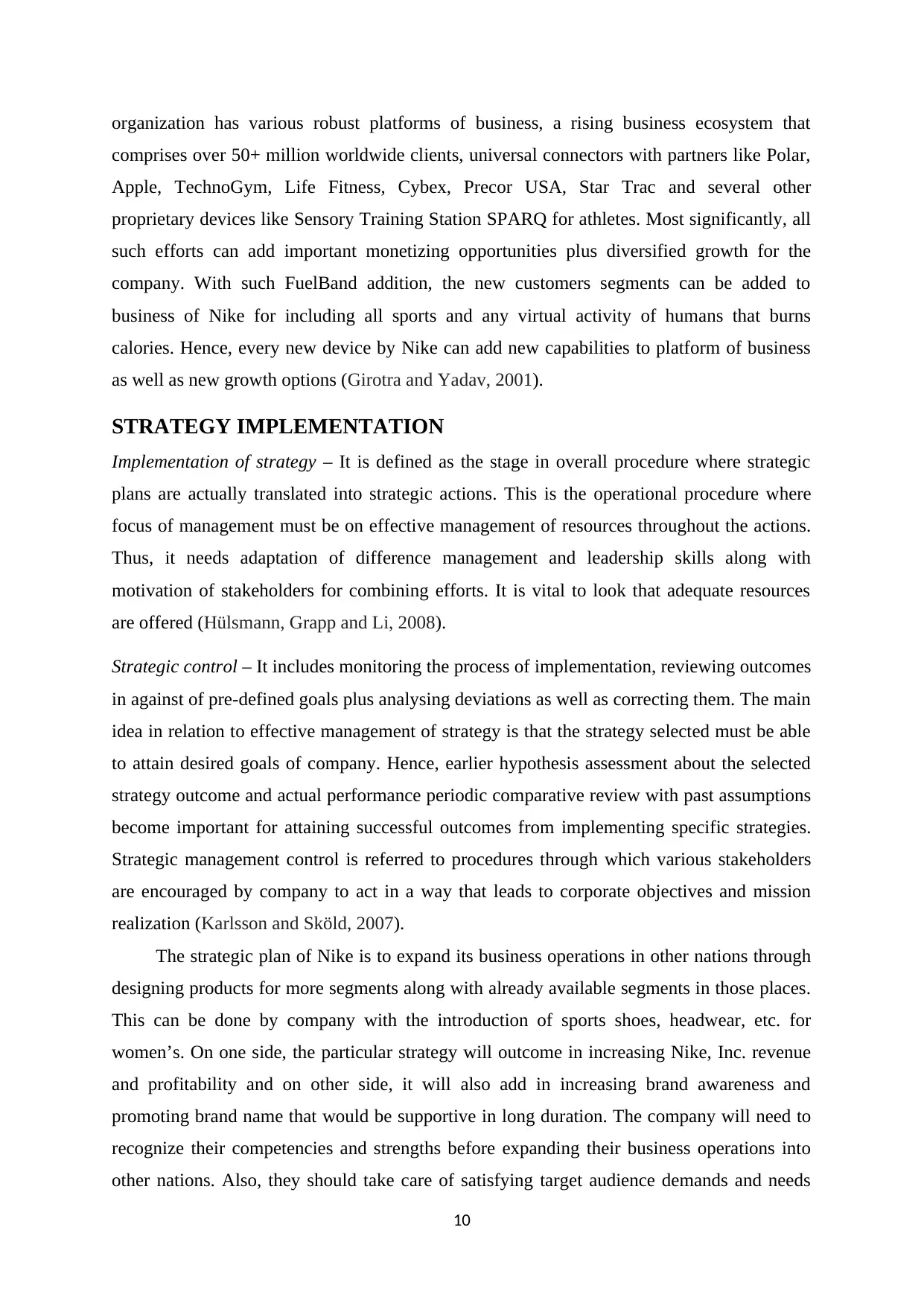
organization has various robust platforms of business, a rising business ecosystem that
comprises over 50+ million worldwide clients, universal connectors with partners like Polar,
Apple, TechnoGym, Life Fitness, Cybex, Precor USA, Star Trac and several other
proprietary devices like Sensory Training Station SPARQ for athletes. Most significantly, all
such efforts can add important monetizing opportunities plus diversified growth for the
company. With such FuelBand addition, the new customers segments can be added to
business of Nike for including all sports and any virtual activity of humans that burns
calories. Hence, every new device by Nike can add new capabilities to platform of business
as well as new growth options (Girotra and Yadav, 2001).
STRATEGY IMPLEMENTATION
Implementation of strategy – It is defined as the stage in overall procedure where strategic
plans are actually translated into strategic actions. This is the operational procedure where
focus of management must be on effective management of resources throughout the actions.
Thus, it needs adaptation of difference management and leadership skills along with
motivation of stakeholders for combining efforts. It is vital to look that adequate resources
are offered (Hülsmann, Grapp and Li, 2008).
Strategic control – It includes monitoring the process of implementation, reviewing outcomes
in against of pre-defined goals plus analysing deviations as well as correcting them. The main
idea in relation to effective management of strategy is that the strategy selected must be able
to attain desired goals of company. Hence, earlier hypothesis assessment about the selected
strategy outcome and actual performance periodic comparative review with past assumptions
become important for attaining successful outcomes from implementing specific strategies.
Strategic management control is referred to procedures through which various stakeholders
are encouraged by company to act in a way that leads to corporate objectives and mission
realization (Karlsson and Sköld, 2007).
The strategic plan of Nike is to expand its business operations in other nations through
designing products for more segments along with already available segments in those places.
This can be done by company with the introduction of sports shoes, headwear, etc. for
women’s. On one side, the particular strategy will outcome in increasing Nike, Inc. revenue
and profitability and on other side, it will also add in increasing brand awareness and
promoting brand name that would be supportive in long duration. The company will need to
recognize their competencies and strengths before expanding their business operations into
other nations. Also, they should take care of satisfying target audience demands and needs
10
comprises over 50+ million worldwide clients, universal connectors with partners like Polar,
Apple, TechnoGym, Life Fitness, Cybex, Precor USA, Star Trac and several other
proprietary devices like Sensory Training Station SPARQ for athletes. Most significantly, all
such efforts can add important monetizing opportunities plus diversified growth for the
company. With such FuelBand addition, the new customers segments can be added to
business of Nike for including all sports and any virtual activity of humans that burns
calories. Hence, every new device by Nike can add new capabilities to platform of business
as well as new growth options (Girotra and Yadav, 2001).
STRATEGY IMPLEMENTATION
Implementation of strategy – It is defined as the stage in overall procedure where strategic
plans are actually translated into strategic actions. This is the operational procedure where
focus of management must be on effective management of resources throughout the actions.
Thus, it needs adaptation of difference management and leadership skills along with
motivation of stakeholders for combining efforts. It is vital to look that adequate resources
are offered (Hülsmann, Grapp and Li, 2008).
Strategic control – It includes monitoring the process of implementation, reviewing outcomes
in against of pre-defined goals plus analysing deviations as well as correcting them. The main
idea in relation to effective management of strategy is that the strategy selected must be able
to attain desired goals of company. Hence, earlier hypothesis assessment about the selected
strategy outcome and actual performance periodic comparative review with past assumptions
become important for attaining successful outcomes from implementing specific strategies.
Strategic management control is referred to procedures through which various stakeholders
are encouraged by company to act in a way that leads to corporate objectives and mission
realization (Karlsson and Sköld, 2007).
The strategic plan of Nike is to expand its business operations in other nations through
designing products for more segments along with already available segments in those places.
This can be done by company with the introduction of sports shoes, headwear, etc. for
women’s. On one side, the particular strategy will outcome in increasing Nike, Inc. revenue
and profitability and on other side, it will also add in increasing brand awareness and
promoting brand name that would be supportive in long duration. The company will need to
recognize their competencies and strengths before expanding their business operations into
other nations. Also, they should take care of satisfying target audience demands and needs
10
⊘ This is a preview!⊘
Do you want full access?
Subscribe today to unlock all pages.

Trusted by 1+ million students worldwide
1 out of 17
Related Documents
Your All-in-One AI-Powered Toolkit for Academic Success.
+13062052269
info@desklib.com
Available 24*7 on WhatsApp / Email
![[object Object]](/_next/static/media/star-bottom.7253800d.svg)
Unlock your academic potential
Copyright © 2020–2025 A2Z Services. All Rights Reserved. Developed and managed by ZUCOL.





